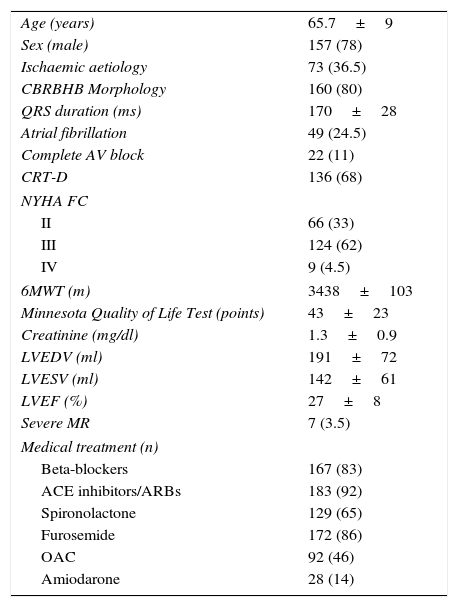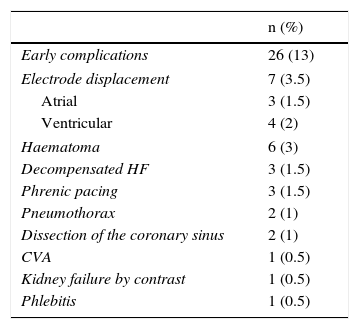Results of cardiac resynchronization therapy (CRT) have been extensively published. However, there is limited data in unselected populations. The objective of the study was to analyze the efficacy and safety of CRT in Catalonia.
MethodsA prospective study was performed of consecutive patients implanted with CRT over one year in 7 university hospitals in Catalonia, representing 90% of the implanted patients. Echocardiographic reverse remodelling was defined as 5 points improvement in left ventricular ejection fraction and clinical responders were defined as patients with an increase >10% of 6-min walk test or one point of New York Heart Association functional class at 12 months. Patients were followed up for one year and hospital admissions and mortality were analyzed.
ResultsOf the 200 patients included in the study, 99% met the indications of the current CRT clinical guidelines and 68% received CRT with implantable cardioverter-defibrillator. The rate of complications was 12.5%. During follow-up 16 patients (8%) died. Fifty-two percent (104) of the population was considered to respond clinically and 62% (124) presented improved echocardiographic parameters. Compared to the year prior to implant, hospital admissions decreased by 82% (P<.001).
ConclusionsIn an unselected population of Catalonia, we observe that CRT was effective and decreased the number of hospital admissions.
Los resultados del tratamiento de resincronización cardiaca (TRC) han sido extensamente publicados. Sin embargo, hay datos limitados en poblaciones no seleccionadas. El objetivo del estudio fue analizar la eficacia y la seguridad del TRC en Cataluña.
MétodosSe analizó prospectivamente una serie de pacientes consecutivos a los que se les implantó durante un año un dispositivo de TRC en 7 hospitales universitarios de Cataluña, los cuales representan el 90% del total de dispositivos implantados. Se definió como remodelado ecocardiográfico inverso el aumento de 5 puntos de la fracción de eyección del ventrículo izquierdo, y respondedores clínicos los pacientes que a los 12 meses habían aumentado>10% la distancia recorrida en la prueba de caminar 6 minutos o un punto la clase de la New York Heart Association. El seguimiento de los pacientes fue por un año y se analizaron los ingresos hospitalarios y la mortalidad.
ResultadosDe los 200 pacientes incluidos en el estudio, el 99% cumplía las indicaciones de las guías clínicas actuales de TRC y el 68% recibió TRC con desfibrilador automático implantable. La tasa de complicaciones fue del 12.5%. Durante el seguimiento 16 pacientes (8%) murieron. El 52% (104) de la población fue respondedor clínico y un 62% (124) presentó remodelado ecocardiográfico. En comparación con el año previo al implante los ingresos hospitalarios se redujeron un 82%, lo que resultó en una diferencia estadísticamente significativa (p<0,001).
ConclusionesEn una población no seleccionada de Cataluña observamos que el TRC fue eficaz y redujo el número de hospitalizaciones.










